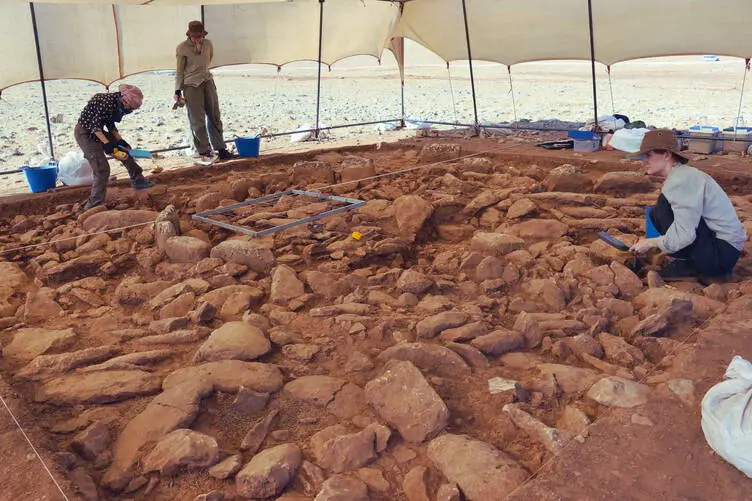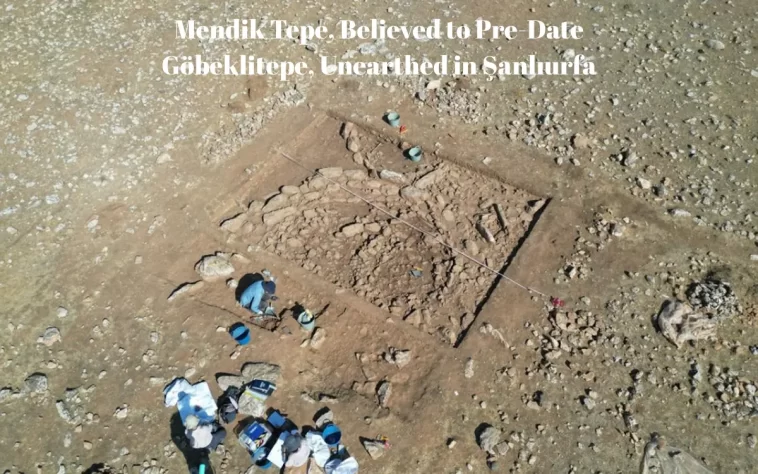Archaeological excavations in Şanlıurfa, Turkey, are shedding light on Mendik Tepe, a settlement believed to be older than Göbeklitepe — the site widely known as the “zero point of history.” Findings suggest that Mendik Tepe may hold critical clues about humanity’s transition to a settled lifestyle during the earliest phases of the Neolithic Age.
This discovery is particularly important because Göbeklitepe has long been considered the turning point in human history, challenging the traditional narrative that agriculture preceded monumental architecture. If Mendik Tepe is indeed older, it would push the timeline of organized, semi-sedentary societies even further back, potentially rewriting the origins of religion, social organization, and technological development.
Discovery of Mendik Tepe
Located in the rural Payamlı neighborhood of Şanlıurfa’s Eyyübiye district, Mendik Tepe was first identified by excavation director Fatma Şahin. Excavations began in 2024 under the leadership of Prof. Dr. Douglas Baird from the University of Liverpool’s Archaeology Department, in collaboration with the Şanlıurfa Archaeology Museum and with support from the British Institute of Archaeology.
The choice of this region is no coincidence. Southeastern Anatolia, particularly the Taş Tepeler (Stone Hills) Project area, has revealed an unparalleled concentration of Neolithic sites. This region is increasingly being recognized as one of the primary centers of human civilization, where innovations such as agriculture, architecture, and spiritual life first flourished.
Excavations Reveal Early Buildings
Professor Baird explained that excavations have uncovered structures of various sizes, and researchers are now working to determine their functions.
“Some of the buildings we uncovered last year are large, while others are relatively small,” Baird told Anadolu Agency. “We are trying to understand these differences. Could the smaller ones have been used for storage or food preparation? Were the medium-sized structures domestic houses? And could the larger ones have served as special ritual spaces? One particularly large structure stands out due to its solid stonework, which strengthens the theory that it may have been used for ceremonial purposes.”
These findings echo the discoveries at Göbeklitepe, where ritual and communal activities seemed to dominate life. However, Mendik Tepe’s variety of structures indicates a more complex social fabric. It suggests that people here may have lived permanently or semi-permanently, balancing everyday domestic activities with ritual gatherings — a step further than the seasonal use many scholars attribute to Göbeklitepe.

Mendik Tepe Older Than Göbeklitepe?
According to Baird, Mendik Tepe may date back to the earliest stages of the Neolithic Period, possibly predating Göbeklitepe and Karahantepe, two of the most significant sites in Turkey’s Taş Tepeler (Stone Hills) Project.
“This settlement is related to the Taş Tepeler sites like Göbeklitepe and Karahantepe, but it may be slightly older,” Baird explained. “Our work here contributes to understanding not only the evolution of the Taş Tepeler Project but also the origins of the Neolithic Age itself. These findings provide vital evidence about how early humans began transitioning to settled life.”
If confirmed, this would mean that humanity’s first experiments with sedentary life and communal organization began not with Göbeklitepe but possibly with Mendik Tepe. Such a revelation could have profound implications for our understanding of early religion, food production, and the birth of symbolic art.
A Unique Architectural Identity
Interestingly, unlike Göbeklitepe and Karahantepe, which feature monumental T-shaped pillars, Mendik Tepe has revealed non-T-shaped standing stones. This architectural distinction hints at unique cultural practices and offers new perspectives on how early communities developed distinct identities during the Neolithic.
The absence of T-shaped pillars may indicate either an earlier architectural phase or a different symbolic system altogether. Instead of monumental depictions of animals or deities, Mendik Tepe might have expressed spirituality and community identity through more modest, yet equally meaningful, stone arrangements. Such differences underscore that early Neolithic societies were not homogenous; they experimented with diverse cultural expressions, adapted to their environment, and interacted with neighboring groups in complex ways.
A Broader Archaeological Context
Mendik Tepe lies only five kilometers from Çakmak Tepe, another excavation site led by Fatma Şahin. Both locations appear to date earlier than other Stone Hills settlements, potentially rewriting what scholars know about the timeline of human settlement in the region.
When considered alongside Göbeklitepe, Karahantepe, and other sites in the Taş Tepeler network, Mendik Tepe highlights southeastern Anatolia as a cultural and technological cradle. Rather than a single “first temple” or “first village,” this region seems to have hosted a network of experimental communities, each contributing to the gradual shift from mobile hunter-gatherers to organized, symbolic societies.
Why Mendik Tepe Matters
As excavations continue, Mendik Tepe promises to play a major role in reshaping our understanding of early human history, complementing the discoveries at Göbeklitepe, Karahantepe, and other Neolithic sites in southeastern Turkey.
Its importance lies not just in its age but in what it reveals about human creativity, adaptability, and spirituality. Mendik Tepe may prove that the origins of civilization were not a sudden “revolution” but a long, dynamic process unfolding across multiple sites. This makes the story of humanity even richer — one that began thousands of years earlier than we once believed.
Key Discoveries at Mendik Tepe (So Far)
- 🪨 Standing Stones (Non-T-shaped): Unlike Göbeklitepe and Karahantepe, Mendik Tepe revealed upright stones with different shapes, pointing to unique architectural and symbolic traditions.
- 🏠 Variety of Building Sizes: Excavations uncovered small, medium, and large structures, suggesting a mix of storage, domestic, and ritual functions.
- 🔨 Solid Stonework: One particularly large structure with impressive masonry may have been used for ceremonial or communal purposes.
- 🍲 Possible Food Storage Areas: Smaller rooms and enclosures are thought to have been used for food preparation or storage.
- 🧱 Early Neolithic Architecture: Structural remains indicate some of the earliest stages of permanent or semi-permanent settlement.
- 📍 Geographical Link: The site lies only 5 km from Çakmak Tepe, suggesting a network of related early communities in the Şanlıurfa region.
- ⏳ Chronological Clues: Preliminary analysis suggests Mendik Tepe may pre-date Göbeklitepe and Karahantepe, making it a candidate for one of the world’s oldest known settlements.
✨ In summary: Mendik Tepe could represent the missing link between the mobile hunter-gatherers of the Paleolithic and the fully settled societies of the later Neolithic. If Göbeklitepe rewrote history, Mendik Tepe has the potential to extend the first chapter of civilization even further back in time.

